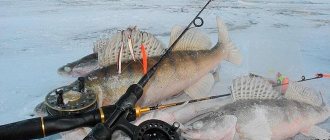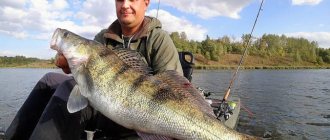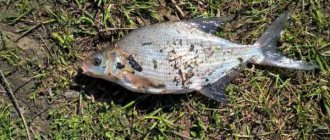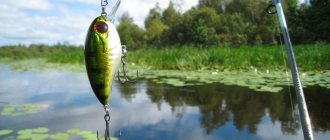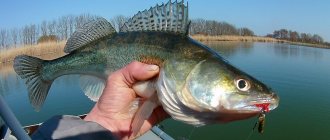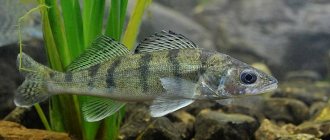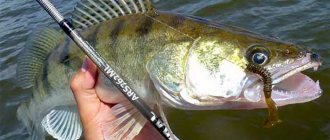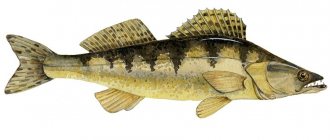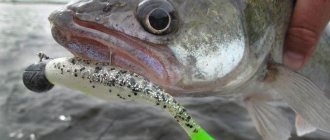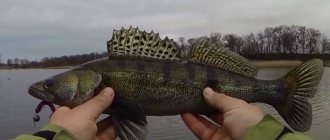Pike perch is a valuable prey fished by fishermen throughout Russia. The value of the predator is an interesting process of fishing, since the fish is quite strong, has a large body size and good taste. Fishing for pike perch is possible throughout the year, except for the only period - spawning. The spawning time of pike perch is a special period in the life of the fish, during which the predator behaves completely differently than usual. In most regions, fishing is prohibited during the spawning season.
Conditions for spawning pike perch
Content
The fanged one becomes sexually mature and capable of reproduction at 3-4 years of age. Typically, females acquire the ability to lay eggs at the age of four years, and males a year earlier. Before spawning, the pike perch already has time to develop to a weight of 0.5-0.7 kg with a body length of 30-40 cm.
When winter ends and the ice cover begins to melt, the fish begins to actively feed. The pike perch prepares to spawn by storing up fat. During the spawning period, pike perch will need a lot of energy to get to the place, pick up a mate, release eggs and fertilize them. At the end of winter or early spring, the predator moves closer to the shore or to shallow areas of the reservoir where schools of fry live. Now is the best time to catch large fanged specimens; trophies are often caught on the hook.
Fishing for pike perch is possible throughout the year.
The preparation time for pike perch takes up to one month; all the time it feeds heavily. The specific period when spawning begins cannot be determined precisely; it all depends on the temperature. The water temperature for spawning pike perch should be between 10-18 °C. In the warm regions of Russia, fish go to spawning grounds in April, in the central part of the country - in May, and in the north, favorable conditions occur in late May or early June. Now most of the reservoirs are entering their usual banks, which symbolizes the end of the spring flood.
Pike perch usually lives in schools; often a group of pike perch consists of a hundred individuals or more. Large fish do not like to stay in schools; they are more comfortable alone, where it is easier for them to find food. After the end of the period of active feeding, the fanged one goes to the spawning ground. The fish swims slowly, absorbing all the food it comes across as it goes. Due to the preservation of the instinct to eat, many anglers hunt pike perch with spinning rods or float gear with live bait.
Read more
How to catch pike perch in winter using girders?
Timing of spawning
In most of Eurasia, pike perch spawning occurs in late spring - after the thermometer crosses the 15-degree mark. In the southernmost regions, where the climate is warmer, it can begin at the end of April, in mid-latitudes - in the second half of May. In the north, pike perch begins to spawn even later - in early or even mid-June.
In the Middle Urals, pike perch usually spawn in the second half of May, although here, again, it all depends on what kind of spring it was. Cold weather, which is not uncommon in the Ural springs, can “delay” the timing of spawning one to two weeks later, approximately the same as in northern latitudes.
The duration of spawning also depends on how quickly the water warms up. It can take place in one step, or it can take a month.
In fact, all pike perch living in the Ural reservoirs are introduced. Natural populations of this fish exist only in large rivers of the Kama Basin, usually in the lower reaches, less often in the middle reaches. Pike perch, which is found in the Ural lakes and reservoirs (Volchikhinskoye, Isetskoye, etc.), as well as some rivers of the Irtysh basin, was artificially populated in the second half of the 20th century. However, it has taken root well in new places and reproduces there every year.
Places where pike perch spawn
The fanged fish spawns approximately after mid-spring, at which time it begins to actively look for a place where it will build a nest for eggs. Predators leave in groups from deep places in the reservoir and swim to the shallows near the shore.
Frequent spawning sites for pike perch:
- eriki;
- small channels;
- oxbow lakes on rivers;
- bays.
Spawning of pike perch in the spring occurs in the listed places, even among the inhabitants of lakes and seas. Now all individuals tend to leave their homes and swim in flocks to suitable sections of rivers.
Spawning is carried out in pre-prepared nests
The predator prefers to make nests in areas of rivers with lush vegetation, snags and other debris. As the mating season approaches, large flocks disperse and small groups of 2-3 males form. If the individuals are large, there is only one male in the pair. Usually, among a group of males, only one participates in the breeding process, which is larger than the rest.
The spawn is thrown into pre-prepared nests. In advance, the female prepares the nest in a secluded place; she actively fans the area with her ventral fins to remove remaining debris and vegetation. The female clears the bottom, creating a clean surface for the eggs. There is work here for the males, who level the ground with their noses. Together, the fanged ones create a depression at the bottom 5-10 cm deep. Pike perch likes to make oval recesses for masonry up to 0.6 m long. Along the perimeter of the nest there are roots with branches that perform a protective function.
There are regions of Russia where pike perch is endangered. The fish simply does not find a favorable place to lay eggs. To help the predator, people arrange suitable spawning grounds. After all, random scattering of eggs leads to the death of all offspring.
To make an artificial spawning ground, vegetation is removed from the bottom and special nests are made from branches or stainless steel. A substrate is placed inside the frame: nylon ropes, vegetation roots. To mark spawning grounds, small floats are attached to the edges.
Spawning grounds
When it's time to reproduce, the pike perch looks for a suitable place to build a nest. Groups of predators leave deep waters, rushing to coastal shallows. These can be river oxbows, bays, eriks, small channels. Even marine and lake inhabitants enter river waters to spawn.
Photo 1. A shallow bay is one of the spawning areas.
The fanged predator makes its nests in areas of the reservoir with an abundance of grass, snags and other debris. Before the mating season, flocks break up into small groups consisting of one female and 2-3 males. Pike perch spawn in special nests, which females begin to prepare in advance. To build a cradle, the fish actively uses its pelvic fins. In this way, it is possible to remove remnants of grass and debris from the bottom, forming a clean area. The males join the female, leveling the ground with their bows. By joint efforts, a space is created with a recess of 5 to 10 cm, shaped like an oval up to 60 cm long. The nest is surrounded by branches and roots, which will protect the masonry from lovers of easy money.
In some regions where the walleye population is endangered, people are trying to help the fish spawn safely. The problem with the reproduction of this predator often lies in the fact that sexually mature individuals do not find a place to lay eggs. As a result of spontaneous spawning, the entire clutch dies. Therefore, caring ichthyologists proposed making artificial spawning grounds.
To organize them, first the reservoirs are cleared of remnants of vegetation so that the fish do not deposit sexual products on them. And then they make nests from stainless steel or vine branches. A special substrate is placed in the formed frame. It consists of nylon ropes and plant roots. To mark artificial spawning grounds, floats on thin cords are attached to the nests. Such spawning grounds do not cause fear or criticism among fish. In them, the caviar successfully turns into fry, increasing the number of pike perch.
How does pike perch behave before spawning?
Before spawning, pike perch gains strength and feeds heavily. Fans of fanged fishing always know when the pike perch goes to spawn, and go fishing in advance - a couple of weeks before sending it to the spawning grounds. Usually the pre-spawning zhor coincides with the flood. Now the predator is swimming close to the surface in search of food - various fry. Flocks of fry can be seen scattering on the water.
Read more
How to catch crayfish using crayfish traps?
To build a nest, fish swim in search of a secluded place
The fanged one is not distinguished by active or unusual preparation for spawning. The fish is energetic, but not too much; there are no noticeable signs of mating on the water. Only occasionally can tails protruding from the water be noticeable. The female takes a position upside down and sways with smooth movements. Mostly the process occurs at night, so few people see it. Then the fish swim in search of a secluded place to build a nest; when they find it, they begin to arrange it.
Behavior of pike perch during spawning
Pike perch is a desirable prey for spinning fishermen, as the predator is large in size and has tasty meat.
It's worth catching a fanged predator once to start catching it seriously. One of the interesting periods of life is the spawning of pike perch. In some regions it is prohibited to catch this fish during the mating season. But a good bite can be observed before spawning, as well as some time after its completion. Under what conditions does pike perch spawn? Immediately after the end of winter and the disappearance of the ice shell from the surface of reservoirs, pike perch begins to feed intensively before spawning. The predator moves to shallow waters following schools of fry. Sometimes the fanged robber has to move long distances upstream. Experienced fishermen consider this period the best time to catch trophy specimens.
Start of spawning of pike perch
The female with a male or several males goes to the prepared nest and begins to lay eggs. The fertility of pike perch is quite high, since one large individual weighing 8 kg is capable of laying 300 thousand yellow eggs in a clutch. Some clutches can reach 1 million eggs. One egg has a diameter of approximately 1 mm. All eggs are fertilized by a male selected for size. The largest pike perch gradually fertilizes the clutch.
The remaining individuals, if there were several males in the group, are engaged in protecting the future offspring. When the spawning of pike perch begins, the predators are aggressive; they scare away the fish swimming nearby, blocking access to those who like to feast on caviar.
Male defenders, often he alone, must periodically clean the masonry, washing off silt from it and aerating the water. If the protective pike perch is caught, the entire clutch dies.
It is impossible to say exactly how many days the spawning of pike perch lasts, but usually the process takes from 10 to 20 days. The eggs develop relatively quickly and after 1-1.5 weeks they already reach a size of 15-20 mm, now the shell opens and the fry comes out.
It is impossible to say exactly how many days the spawning of pike perch lasts.
Spawning process
In search of spawning sites, sexually mature individuals leave deep places in small groups and enter shallow water. In each group there is only one female and several (from two to four) males who accompany her. Fish are very responsible when choosing places where they will spawn. Usually such places become thickets of underwater vegetation, where pike perch make real nests, which have a round or oval shape - with a small depression in the middle. First, the female stands in one place for some time, turns and creates powerful currents of water with the movements of her fins - they wash away bottom debris and some of the silt. Then in the center of the nest she makes a small depression with her nose, after which she lays eggs and leaves. Depending on the size of the female, her fertility ranges from 70 thousand to 1 million eggs.
Only one male fertilizes the eggs; the rest leave with the female. He remains at the nest during the entire period of embryonic development, which lasts about a week. At this time, the male “ventilates” the eggs with movements of his fins, thereby aerating them and protecting them from silting. He also guards the clutch and violently attacks any creature that approaches the nest closer than a meter [1] For such behavior, fishermen and ichthyologists call the male guarding the clutch a “guard pike perch.” This complex behavior is caused primarily by the low survival rate of eggs.
If you frighten a pike perch, it will leave the clutch, but after a while it will return to it. If you catch it at this moment, the clutch will be doomed to death. That is why it is categorically undesirable to catch pike perch during the spawning period, as this can greatly undermine their population.
Pike perch after spawning
After most of the young hatch from the eggs, the adults leave the clutch and go to deep places in the reservoir. The young animals continue to grow rapidly, the pace of development directly depends on the food supply. At first they feed on the egg substrate obtained from the eggs, and then they switch to plankton.
If conditions are conducive to the development of pike perch, by winter the fry reach a length of about 20 cm. In conditions of lack of food, young animals rarely cross the 10 cm line. As soon as the temperature drops significantly, the growth of the fry stops until the weather warms up.
It's time to multiply
This predator becomes sexually mature at three or four years of age. At the same time, males mature a year earlier. Pike perch spawn in May or June, depending on temperature. The optimal conditions for laying eggs are considered to be fifteen to eighteen degrees Celsius in a pond. At this time, this predatory fish, gathering in mating groups, begins to leave the usual hunting grounds.
Flocks, which consist of several males and one female, rise from great depths, from holes and dumps, where a strong current helps to obtain food. They begin to look for other places, those that are convenient for laying eggs.
Sad statistics
Pike perch, despite the fact that it still retains its numbers in some rivers, is under threat of complete extinction from the water bodies of many regions of our country. The reason is that sometimes in reservoirs and large lakes it simply does not find a suitable place for reproduction. And if the spawning of pike perch ends with the spontaneous release of eggs, then they will soon all die. But this fish can still be saved. If a person comes to her aid and creates artificial spawning grounds for her everywhere, then she will be happy to spawn there.
